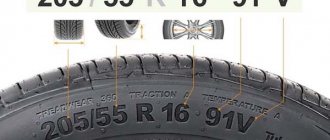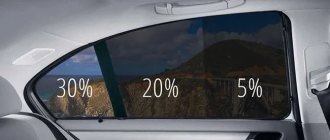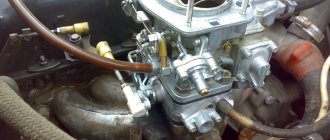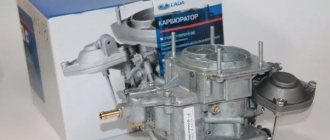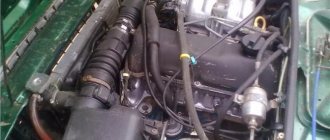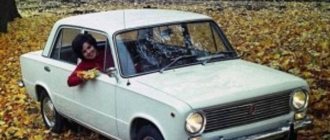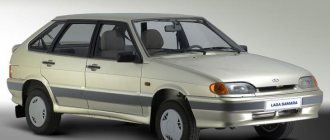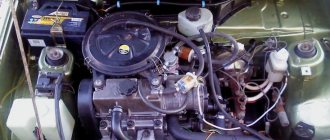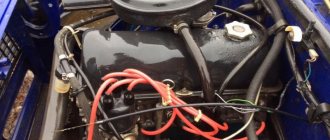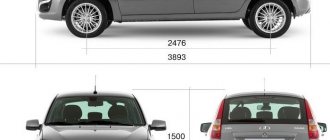Wires for lighting a car are an indispensable thing, especially in the cold season in Russia.
In winter, almost every driver has had this problem when the car won’t start - the battery is dead or faulty. This can happen due to an old battery, headlights not being turned off in time, or the radio being left on. Severe frost also negatively affects the battery's electrical capacity. In such an unpleasant situation, a donor car can come to the rescue and start your car, and you can drive to a place where you can recharge or change the battery.
Why do you need wires for lighting?
Wires for lighting a car (or starting wires) already from their name determine their purpose - to supply energy sufficient to start the car from the battery of one car to another. That is, you start your car using the battery of someone else's car. Wires for lighting must have the necessary characteristics:
- must be able to withstand the large current that passes through them during startup;
- should not lose their properties in severe frosts, when they are most in demand;
- the wires must provide high-quality contact.
Therefore, you should pay attention to the materials from which the wires are made, since they are subject to certain requirements.
Wires for lighting
The wires for lighting a car have a simple structure and consist of:
- stranded copper wire enclosed in durable frost-resistant insulation;
- and alligator clips are installed at both ends.
Starting current
When starting a car, the battery has to give off energy in very large quantities to turn the engine. If we are talking about a car with an engine of up to 1.5 liters, then the minimum starting currents reach 200 A. If the engine is more powerful, then the starting currents can reach 400 A. In severe frost, when the oil thickens, it is even harder for the starter to crank the engine and the currents are higher.
Naturally, in order to pass such currents, the wires for lighting must have stranded, high-quality wire of the appropriate cross-section. The amount of current that needs to be passed through the wire depends on its resistance.
The wire resistance depends on:
- material - the lower the resistivity of the wire, the lower the overall resistance;
- diameter - the larger the cross-sectional area of the wire, the lower the resistance;
- length - the longer the wire, the higher the total resistance of the conductor.
Metal core material
The conductor that has the lowest resistivity is silver. But wires are not made from silver because of its high price and hardness. The most suitable material for cores is copper. It bends quite well and conducts electricity. Some manufacturers use aluminum coated with copper to make cables. But, aluminum conducts electricity worse than copper and silver, and is less resistant to bending, so aluminum strands will break during use.
Wire diameter
From the electrical engineering course we know that 1 mm2 of copper wire allows a current of no more than 8 Amperes to pass through. With a starting current of 200 A, the cross-sectional area must be at least 25 mm2. From the cross-sectional area formula, you can calculate the cable diameter: S = ¼·π·D², where:
S – wire cross-sectional area;
D – wire diameter;
π – number equal to 3.14;
From this formula we find the diameter, it turns out to be 3 mm. But you need to understand that this is the diameter of a solid wire, and the cable consists of 3 dozen cores. Over time, some wires in the cable may break during operation, and the actual cross-section will decrease. It is better to choose the minimum diameter of a multi-core cable as 6 mm, and preferably 10-12 mm.
Insulation material
The wire insulation material is also extremely important. Since the wires for lighting a car are most in demand in winter during severe frosts, when the load on the battery increases and it often fails, the protective coating of the wires should retain its functions even at significant subzero temperatures. The insulation must be strong; elastic; maintain flexibility, not harden or break in severe frosts; and at the same time insulate the wire well.
Typically used for insulation:
- soft polyvinyl chloride,
- rubber,
- silicone
Polyvinyl chloride and rubber at very low temperatures (-45°) harden and crack. Low-quality wires may have a very thick layer of rubber, and underneath there is a thin wire that cannot pass high current. Frost-resistant rubber also has a disadvantage - the wires under it are highly oxidized.
Silicone braiding is not as durable as rubber, but it remains soft and flexible even in the coldest temperatures.
Alligator clips
Serrated alligator clips are the main working part of the cigarette lighter wires; they cling to the battery terminals, so they also have certain requirements.
The clamps must have the following characteristics:
- they should consist of copper, which has good conductivity, or at least a combination with copper teeth. Often, cheap wire models have clamps made of inexpensive metals coated with copper plating; Such wires are ineffective.
- The crocodile clips should be soldered to the wires and not bolted on. Such wires are stronger, more durable, and there is no risk of the clamps coming off.
- Alligator clips must grip the battery terminals very tightly and tightly; the quality of energy transfer depends on this, since a lot of energy is lost at the connections. The larger the contact area between the crocodiles and the terminals, the better.
- It is necessary to have insulation on the handles of the clamps; it reduces heating and prevents the wire from sparking under heavy loads.
Wire length
Car ignition wires come in different lengths, and this is where length matters. Most often, wires with a length of 2 to 5 meters are available for sale. It would seem that the longest wires would be most convenient. But in practice, unfortunately, this is not always the case. The laws of physics state that the longer the cable through which current flows, the higher the resistance and voltage loss. For 1 meter of starting wire there is a drop of 1 V. Long wires have low efficiency.
The length of the wires should be optimal. If it is longer than 4 meters, there will be a large voltage loss. Wires that are too short will require placing cars back to back, which is not always possible. The optimal wire length is 3 meters.
What are they?
A banal situation: winter, severe frost, you need to urgently go to a meeting (take your child to school, drop your wife off at work, help a friend get to the train station or airport). You get into the car, turn the ignition key - there is no reaction. The battery is clearly discharged. Maybe his time has come, maybe you forgot to turn off the lights at night. The situations are different, but the result is the same - the car refuses to start. There are several options to correct this unenviable situation: find a tow vehicle or run to the nearest auto store and buy a new charger. But the easiest way out of the situation is to ask the compassionate driver to light a cigarette from his personal, working car. You just need to have the starter cables with you.
The market is filled with this kind of products from Russian and foreign manufacturers. It can be budget and expensive, for cars and trucks, with different wire cross-sections and different clamp options. Devices have many names. Some call them crocodiles, others – starting-charging elements, and still others – starter cables. All these are synonyms for one product that is ready to cope with the task of transferring current from a working battery to a “dead” one.
Much attention must be paid to the cross-section of the cable, its length and the quality of the material. It is worth keeping in mind that the resistance indicator directly depends on the cross-section value. The larger it is, the less resistance. The optimal cross-section for starting elements is from 6 to 10 sq. mm.
What to look for when buying cigarette lighter wires
Now the automotive market offers a huge number of wires for lighting cars from various manufacturers. What should you pay attention to when purchasing in order to choose high-quality jumper wires and not waste your money?
We look at the following parameters:
- The declared maximum current must be at least 400 A.
- The thickness of the internal cable must be at least 9 mm. Some manufacturers sin by increasing the thickness of the insulation, but the core is not thin, which leads to an increase in resistance and a decrease in current. Such wires will not be able to start the car.
- Only copper wires should be selected. In no case - not copper-plated aluminum.
- The most optimal wire length is 3-4 meters.
- Alligator clips must be made of copper, soldered to the wires, firmly grip the terminals, covered with insulation, with a maximum contact area with the battery terminals.
- The insulation should be soft enough, but strong, and retain its flexibility in the cold.
- The wires should be of different colors so as not to accidentally reverse the polarity of the contacts.
Length
On the domestic market, as a rule, sets of starting wires are on sale, the length of which varies between 2-5 m. Some car enthusiasts believe that the longer the cable length, the better (it is easier to connect two batteries from cars located at a great distance from each other). On the one hand, this is true, but on the other, you need to take into account the fact that the longer the cable, the higher the loss of passing voltage and the greater the resistance.
To light a discharged battery from other energy sources (chargers, batteries of other cars), it is preferable to purchase a starting cable 3-4 m long. To be able to restore the battery at home, you can purchase a cable whose length is up to 2.5 m.
Wires for lighting yourself
If it is not possible to buy wires for lighting a car, you can make them yourself. To do this, you need to select the appropriate cable and alligator clips.
Wire selection
An excellent option for making starter wires would be wires used for welding. They have the required thickness, conductivity and insulation. Or you can buy wires at any electrical store. KG brand wire is best suited. The cable cross-section should not be less than 25 mm3. The diameter of the cores should not be less than 9 mm. Pay attention to insulation. It’s good if the insulation is marked HL, this means that it is frost-resistant. Take a 6 meter long wire and cut it in half.
Clamp selection
We take the clamps in the same place as the wires. Welding holders work well. It's even better to buy standard factory crocodile clips. They already have a plastic insulated case. When purchasing, check the quality of the clamp, the material (preferably copper), and the contact area (preferably large). Buy alligators in different colors to indicate the polarity of the wires.
Wire assembly
The assembly sequence is simple:
- clean and tin the ends of the prepared wires;
- insert the wire into the lug and crimp it;
- solder the wires to the clamps;
- isolate the open parts, leaving only the crocodiles to graze.
The terminals of different wires must be different in color, so as not to confuse the polarity during use.
Rating of inexpensive high-quality devices
KRAFT KT/880002, 400 A, 2.5 m
The starting wires are made of high quality copper. Thermoplastic rubber acts as an insulating layer. They belong to the frost-resistant category. Withstands temperatures from -40 to +80 degrees. Length – 2.5 meters. How many amps do the wires have? The maximum current indicator is 400 A. There is no question of how to connect them. At the ends there are special clips - crocodiles.
The average price is 849 rubles.
Advantages:
- practical;
- convenient to use;
- withstand severe frosts;
- high quality copper;
- optimal length;
- The set includes a convenient bag - a cover.
Flaws:
- not installed.
Nova Bright
The products of the American brand are produced in the Middle Kingdom. Belongs to the category of budget models. The length varies from one and a half to two and a half meters. The structures are made separately. The insulating layer is transparent plastic. The double crimp method is used to connect the clamps and cable. The crocodiles are steel, coated with copper plating. The total cross-section is 4.2 sq. mm.
You can purchase the product at a price of 275 rubles.
Advantages:
- good characteristics;
- ease of operation;
- reliability;
- functionality.
Flaws:
- the cross section is too small.
Battery 400 A ARNEZI A0102004
The diameter of the wires is 9 mm, the length is 2.5 meters. They operate with a voltage of 12/24 V. They consist of 170 cores. The operating temperature indicator is from +80 to – 40 degrees. Insulation – polyvinyl chloride. Designed to start the engine using a working battery. Belong to the universal type. Reviews about the product are only positive.
The average cost is 680 rubles.
Advantages:
- long service life;
- practicality;
- ease of use;
- reliability;
- safety;
- The set includes a bag for transportation;
- value for money.
Flaws:
- not installed.
Battery ARNEZI A/0102006
The product is 2.5 meters long. The total number of cores is 64 pieces. Wire diameter – 7 mm. Supply voltage – 12 V. Current indicator – 150 A. Insulating material – silicone. It functions efficiently at 80 degrees of heat and 40 degrees of frost. If there is not enough charge on your own car, it will help to start it with the help of another donor car. For ease of transportation, a high-quality bag is provided.
The purchase price is 374 rubles.
Advantages:
- ease of use;
- functionality;
- withstands extreme heat and severe frosts;
- does not crack or melt;
- reliable;
- durable.
Flaws:
- none.
STANDARD AIRLINE SA/150/07S
The product is manufactured for lighting batteries. Length – 2 meters. Current strength – 150 A. Very convenient for use by car owners. It will help you quickly get out of a situation when the battery is dead. Can be used both in hot and cold weather. Completely safe. You can purchase it at specialized retail outlets or order it online in an online store.
Purchase price – 243 rubles.
Advantages:
- ease of use;
- reliable;
- acceptable length;
- inexpensive;
- long service life.
Flaws:
- not installed.
Stels 55917
The main task of the starting wires is to provide additional recharge to the starter in a car with a discharged battery or oil that has thickened in severe frost. Length – 2.3 meters, current – 200 A. Belongs to the category of universal goods. Purchased by owners of both trucks and passenger vehicles. They will help start the car during long-term storage in the cold season, when the battery has completely self-discharged.
The average price is 820 rubles.
Advantages:
- versatility;
- practicality;
- reliability;
- durability;
- acceptable cost.
Flaws:
- none.
The ringleader
Product from a domestic company with production facilities in St. Petersburg. You can purchase it at any specialized retail outlet at an affordable price. The declared current indicator is only 220 A, but even this is not achieved in reality. Length 2 meters. Not afraid of the cold.
How to light a car correctly
In cold weather, even new batteries are subject to heavy loads and often fail, so the need to light a car may arise at any time, or you may be asked for help. Therefore, you need to know how to light a car correctly, so as not to harm your own or someone else’s car. It is advisable to use a car with an engine of equal or greater displacement as a donor car. But, in principle, you can launch a gazelle from Matis.
Step-by-step instructions on how to light a car:
- We position the cars so that the wires can be connected without tension.
- The donor car should run for 5-10 minutes at 2000-3000 rpm in order for its battery to recharge a little.
- We turn off the donor car and turn off the ignition.
- We turn off all electrical appliances in both cars: headlights, interior lighting, radio, heater, air conditioning, navigator.
- We inspect the battery of a car that does not start: there should be no smell, cracks in the case, or leaks of electrolyte.
- We connect one end of the “positive” wire first to the battery of the donor car (from which we will light the cigarette), the other end to the battery of the recipient car.
- We connect one end of the “negative” wire to the negative of the donor battery, the other end to any metal surface of the car that is free of paint (this could be the engine block). If the car does not have such a place, then we connect the second end of the “negative” wire to the “minus” of the battery of the recipient car.
- It is very important to maintain polarity when connecting wires: one wire must connect two pluses, the other - two minuses. If connected incorrectly, a short circuit will occur, which can damage all electronics of both cars.
- We start the engine of the recipient car. With a normal donor battery and the correct connection of the ignition wires, the car should start without problems. We leave it idling, without turning it off.
- We disconnect the wires in the reverse order: first the negative wire from the recipient, then from the donor; then “plus” from the recipient, then from the donor.
- We say thank you and leave.
Safety precautions when lighting a car
When lighting one car from another, it is important to observe safety precautions, because when the engine starts, there is a possibility of a spark occurring on the “negative” wire, and if the polarity is not observed, the electronics may fail.
Safety regulations:
- Light up cars outdoors or in a well-ventilated area.
- When starting the engine of the recipient car, the engine of the donor car must be turned off. When starting from a running car, the electronics in both cars can burn out.
- Observe polarity when connecting, otherwise a short circuit will occur, which may cause the wire insulation to catch fire.
- Therefore, keep a fire extinguisher ready.
conclusions
- Even if your car has just come off the production line and the battery is new, remember that the capacity of even the newest battery drops by half at temperatures below -19°C. Immediately purchase or make high-quality wires for lighting your car and put them in the trunk.
- In severe frosts, it is better to remove the battery and take it to a warm place.
- Before starting, you can turn on the light for a while. The lighting current will cause the battery electrolyte to warm up a little.
- Be sure to follow the safety rules and instructions so as not to damage the electronics of your or someone else’s car.
Putting it all together
So, you have two pieces of wire and four clips of different colors. You will need a sharp knife to strip the ends of the wire and some plastic zip ties. Attach clamps of the same color to one of the wires. Using tightening ties, tighten the fastening of the wire in the clamp. Repeat this procedure with the other wire. That's all - now you have your own wires for lighting.
With your own hands you have assembled an indispensable accessory for the winter road. It should be noted that high-quality frost-resistant wires cost about 1,600 rubles. When collecting wires for lighting, you will spend on average the following amounts:
- welding cable with a cross-section of 25 mm, length 5 meters - 710 rubles;
- four clamps for connecting ground, a total cost of 400 rubles.
In total, your reliable and high-quality cigarette lighter cables cost you 500 rubles less than those offered in car stores.
Having spent very little time, you will be absolutely sure that these wires are reliable and will always be able to help if necessary.
Now you can not only help yourself out in a difficult situation, but also help your friends or other road users.
